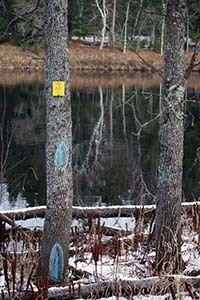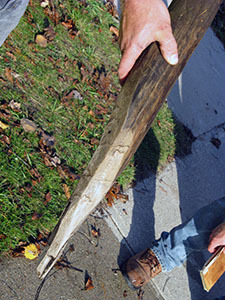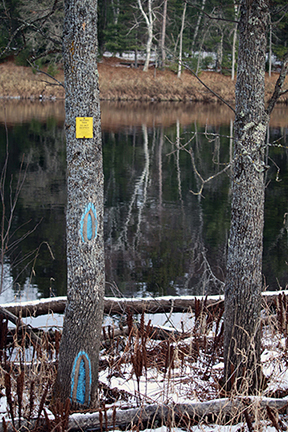NORTHERN MICHIGAN – Meridian Road. Baseline Road. Townline Road. Rangeline Road. Section Street.
These road and street names refer all the way back to the early 1800s, when the U.S. Congress established a General Land Office and created the Public Land Survey System.
Early land surveyors systematically divided Michigan into a grid of 1-mile squares, marked with wooden corner posts at half-mile intervals, following a north-south meridian, an east-west baseline, township lines, range lines and section lines.

The posts – known as monuments – would be the basis for documenting ownership of land and establishing cities and villages, roads, streets, bridges and the boundaries of public and private lands. Life for a surveyor back in those days was not one of luxury. Michigan was vast, forested and swampy with no roads, no GPS and no easy ways for the surveyors to get where they were going. It wasn’t uncommon for surveyors from southern Michigan to make their way to the western Upper Peninsula by walking to Saginaw Bay, where they’d catch a steamer to Sault Ste. Marie. There, they might hook up with a canoe-paddling voyageur for a ride west before walking inland to commence their surveying work. Now that’s a rough commute. “The logistics of what they had to do to survey some of the areas of our state is just amazing,” said Jeremy Pipp, a surveyor with the Michigan Department of Natural Resources who is based in the U.P. town of Norway. “You’ve got to appreciate these extraordinary individuals, enduring these hardships, and completing their assigned work.” Pipp is one of seven land surveyors and four technicians who mark as many as 1,000 boundary corners in a year on 4 million acres of state forest land. They’re called in to mark boundaries for timber sales and resolve property line disputes between the state and private property owners. |

“We want to define the boundaries for the benefit of the department, which also benefits the adjoining land owners and the public,” Pipp said. “Good boundaries make for good neighbors.” The DNR puts monuments on its corners using galvanized steel pipes, capped with an aluminum disc stamped with the land surveyor’s license number and the corner’s location within the Public Land Survey System. Mirroring the work of the original surveyors, DNR surveyors mark (blaze) nearby trees, inscribe them and provide measurements as to how far they are from monuments. These “bearing trees” or “witness trees” help surveyors locate the monument again when needed. All the information is recorded in the county Register of Deeds’ office. State surveyors are responsible for finding and re-marking the sites of the original boundary monuments put in place during the 1800s. That task often involves a good bit of old-fashioned sleuthing, which might start by looking up land records at the county courthouse and end by searching for clues out in the woods after riding a four-wheeler or a snowmobile to the area. “It’s a nice mold of art, science, archaeology, mathematics and geometry all mixed into one,” Pipp said. “You gather all of this information and say, ‘What does this mean and how does this all come together?’” |

The original wooden posts from those early surveys have weathered away over time, and often all that remains is a depression in the ground or, just below ground, the pointed base of an original survey post. “Underground a post point can be preserved like the day they put it in,” Pipp said. Finding one of those is “fantastic,” Pipp said. “Someone drove a post into the ground and took some notes nearly 170 years ago, and through your retracement skills you were able to recover this monument,” he said. In 2012, state surveyor Matt Dontz and a student assistant found an original monument post set in 1850 – a sharpened cedar log – immersed in water that protected it from the elements. “At that moment I knew I was living the highlight of my surveying career to date and possibly my entire career,” Dontz wrote about the incident. His quest started with handwritten copies of original land office notes in Montmorency County, north of Atlanta in the northeast Lower Peninsula. Those notes led to a stream in a swampy area, where the original stake was found. John Nutkins, who works out of the DNR’s Newberry office, has been surveying for 19 years. He also has found an original post or two, but said it is more common to find the bearing trees nearby. Those include originals and trees that were marked in the 1950s, ‘60s and ‘70s. “Actually, you see quite a few of them; it’s neat,” he said. “It’s the ones that haven’t been found by somebody else yet that you get really excited about. Besides marking the grid lines for townships, ranges and sections, the original surveyors also were charged with evaluating the environment in the area where they were working. A 19-point list of things to put in field notes included:
Many of Michigan’s early state surveyors were meticulous, as is evident by comparing record measurements with those made with modern equipment. Other surveyors weren’t quite as precise, which can mean more detective work for today’s surveyors trying to trace old lines. |

Michigan’s state surveyors these days use a combination of old-school and modern techniques. Surveying has continued to evolve to use GPS, and some surveyors are using technology such as drones. But the heart of the profession is the same: to ethically determine and mark property lines. “Some of the (early) surveyors were really diligent conducting their original surveys, and some were not,” Pipp said. When the original points are elusive, “you’ve got to try and come up with a hypothesis and find evidence to support that. The goal is to be in harmony with the original survey.” Where does it all start? Michigan’s grid of townships, ranges and sections originates from a location southeast of Leslie, now memorialized in the 108-acre Meridian-Baseline State Park. The park straddles Ingham and Jackson counties and contains Michigan’s two initial points. It’s about a 1.5-mile round-trip hike to the historic points. The park is on the west side of Meridian Road, just north of Territorial Road. The exact coordinates of the historic point, for anyone interested, are: LAT 42.422854000000001 LONG -84.364743000000004. ### Up North Voice and UpNorthVoice.com are Northern Michigan’s source for community news. We cover seven counties that include the following communities: Roscommon, St. Helen, Houghton Lake, Prudenville, Grayling, Frederic, Waters, Gaylord, Johannesburg, Lewiston, Atlanta, Comins, Fairview, Mio, Rose City, West Branch, Skidway Lake, Hale, Sand Lake area, Glennie, Oscoda, East Tawas, Tawas City, and National City.
|



